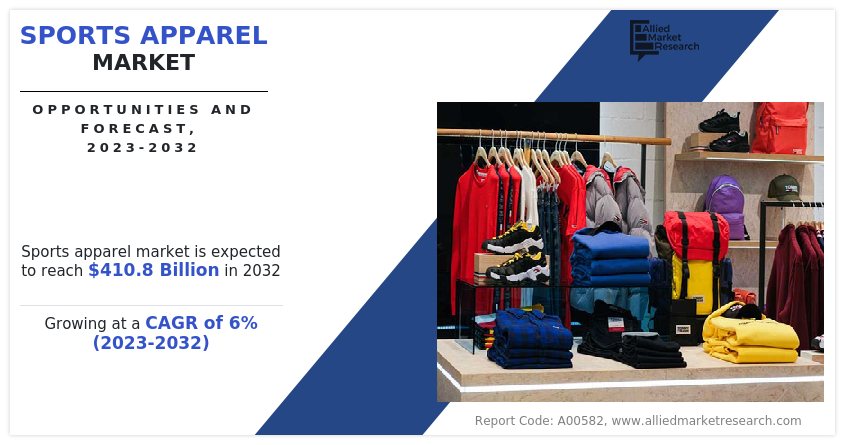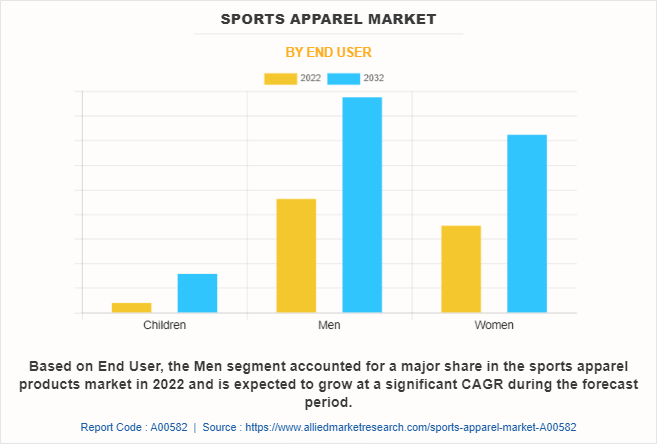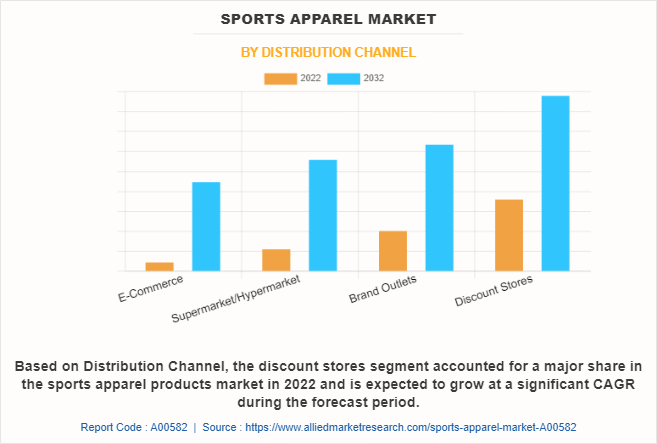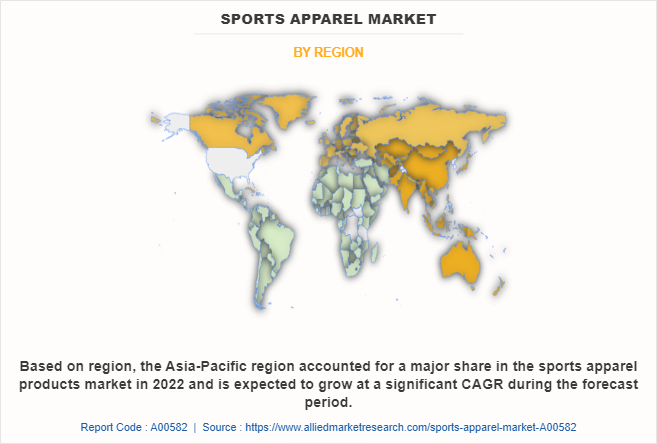Sports Apparel Market Overview, 2032
The global sports apparel market size was valued at $230.6 billion in 2022, and is projected to reach $410.8 billion by 2032, growing at a CAGR of 6% from 2023 to 2032.Sports apparel refers to specialized clothing and accessories designed for various sports & physical activities. It is specifically crafted to enhance performance, and provide comfort to athletes & fitness enthusiasts. It encompasses a wide range of garments such as jerseys, shorts, t-shirts, leggings, shoes, socks, and hats. These garments are often made from lightweight, breathable, and moisture-wicking materials that help regulate body temperature and keep athletes dry during intense physical exertion. In addition, sports apparel may feature technologies such as compression, stretchability, and ergonomic designs to optimize movement and support muscles. Alongside functional aspects, sports apparel simultaneously serves as a form of self-expression, showcasing team colors, logos, and personal style. Whether ’it is for professional athletes, amateurs, or fitness enthusiasts, sports apparel plays a crucial role in promoting comfort, performance, and overall sporting experience.

The sports apparel market demand has experienced remarkable growth in recent years, driven by a combination of factors such as change in consumer preferences, and rise in the trend of athleisure wear. One of the key growth drivers in the sports apparel market is increase in focus on health & fitness. As individuals become more health-conscious and strive for an active lifestyle, the demand for sports apparel has surged. Consumers are actively seeking comfortable & performance-enhancing clothing that allows them to engage in various fitness activities.
Rise of athleisure trend has been another significant growth driver that has blurred the lines between athletic apparel and everyday fashion, enabling consumers to seamlessly transition from workouts to casual wear. In addition, technological advancements have played a crucial role in transforming the sports apparel industry. Innovative materials and technologies such as moisture-wicking fabrics, compression technology, temperature regulation, and antimicrobial properties have revolutionized performance & comfort associated with sports apparel. These features have become increasingly important to consumers, driving the demand for sports apparel with enhanced functionality. In recent years, influencer marketing and brand collaborations have become instrumental in promoting sports apparel brands. By partnering with social media influencers, athletes, and celebrities, brands can leverage their reach & credibility to enhance brand visibility & desirability among consumers. These collaborations help create a strong brand image and connect with target audiences on a more personal level.
In addition, the industry faces intense competition from both established players and emerging brands. Thus, to stay competitive, sports apparel companies need to continuously innovate, invest in R&D, and offer unique products that meet evolving consumer demands.
Despite the challenges, there are numerous growth opportunities in the sports apparel market. For instance, e-commerce has emerged as a significant avenue for growth, allowing brands to reach a wider customer base and provide a convenient shopping experience. With increase in popularity of virtual fitness platforms, there is simultaneously a growing market for specialized sports apparel designed for specific activities such as yoga, cycling, and running. Furthermore, sustainability has become a critical focus for both consumers and brands as a result of which, there is rise in demand for eco-friendly and ethically produced sports apparel. Companies that embrace sustainability in their manufacturing processes and offer environmentally conscious products have the opportunity to differentiate themselves and attract conscious consumers.
The sports apparel market forecast is segmented on the basis of end user, distribution channel, and region. By end user, it is classified into children, men, and women. As per distribution channel, it is classified into e-commerce, supermarket/hypermarket, brand outlets, and discount stores. Region wise, it is analyzed across North America (U.S., Canada, and Mexico), Europe (Germany, France, UK, Italy, Spain, and rest of Europe), Asia-Pacific (China, Japan, India, Australia, and rest of Asia-Pacific), and LAMEA (Brazil, South Africa, UAE, and rest of LAMEA).

By end user, the men segment accounted for a major Sports Apparel Market Share in 2022 and is expected to grow at a significant CAGR during the forecast period. This growth is attributed to increase in participation in sports and fitness activities by men across different age groups and demographics. Moreover, men are becoming more health-conscious, seeking active lifestyles, and investing in sports apparel that aligns with their fitness goals.

As per distribution channel, the discount stores segment accounted for a major share in the market in 2022 and is expected to grow at a significant CAGR during the forecast period. This growth is attributed to factors such as price sensitivity, need for budget-friendly options, availability of a variety of products, and expansion of discount retail chains. These factors collectively contribute to increase in popularity and presence of discount stores in the sports apparel industry.

Region wise, Asia-Pacific accounted for a major share in the market in 2022 and is expected to grow at a significant CAGR during the forecast period. The market in Asia-Pacific has a huge growth potential due to growth in purchasing power of consumers and increase in the middle-class population. Apart from this, rise in marketing initiatives such as heavy marketing campaigns and celebrity endorsements further fuels the sports apparel market growth in the region. Market players should offer quality products to customers at affordable prices to expand their customer base and gain a strong footprint in the market. Moreover, they need to establish retail stores to expand their outreach and increase market share.
The major players operating in the market focus on key market strategies, such as mergers, product launch, acquisitions, collaborations, and partnerships. Further, they focus on strengthening their market reach to maintain their goodwill in the ever-competitive market. Some of the key players in the sports apparel market report include Adidas AG, Nike, Inc., Puma SE, Under Armour, Inc., Ralph Lauren Corporation, Umbro Ltd., Fila, Inc, Lululemon Athletica Incorporation, New Balance Athletic Shoe, Inc., and Columbia Sportswear Company.
Key Benefits For Stakeholders
This report provides a quantitative analysis of the market segments, current trends, estimations, and dynamics of the sports apparel market analysis from 2022 to 2032 to identify the prevailing sports apparel market opportunities.
The market research is offered along with information related to key drivers, restraints, and opportunities.
Porter's five forces analysis highlights the potency of buyers and suppliers to enable stakeholders make profit-oriented business decisions and strengthen their supplier-buyer network.
In-depth analysis of the sports apparel market segmentation assists to determine the prevailing market opportunities.
Major countries in each region are mapped according to their revenue contribution to the global market.
Market player positioning facilitates benchmarking and provides a clear understanding of the present position of the market players.
The report includes the analysis of the regional as well as global sports apparel market trends, key players, market segments, application areas, and market growth strategies.
Sports Apparel Market Report Highlights
| Aspects | Details |
| Market Size By 2032 | USD 410.8 billion |
| Growth Rate | CAGR of 6% |
| Forecast period | 2022 - 2032 |
| Report Pages | 333 |
| By End User |
|
| By Distribution Channel |
|
| By Region |
|
| Key Market Players | Nike, Inc., New Balance Athletics, Inc., Fila Holdings Corp., Ralph Lauren Corporation, Adidas AG, Puma SE, Columbia Sportswear Company, Iconix International, Under Armour, Inc., lululemon athletica inc |
Analyst Review
According to the insights of the CXOs, the global sports apparel market is expected to witness robust growth during the forecast period. This is attributed to Increase in Awareness Related to Health & Fitness. Increase in awareness related to health & fitness is a significant driver fueling the growth of the sports apparel market. With more people prioritizing physical fitness & well-being, there has been surge in sports participation and fitness activities. This trend has resulted in rise in demand for sports apparel as individuals seek comfortable & functional clothing for their workouts. According to the Physical Activity Council's 2022 Participation Report, over 54.9% of Americans aged six and older participated in individual or team sports in 2020. With a heightened focus on health & fitness, individuals are demanding sports apparel that suits their respective needs.
However, the sports apparel market is vulnerable to counterfeit products, which can negatively impact brand reputation and consumer trust. Counterfeit items often lack the quality, performance features, and durability associated with genuine sports apparel. Brands need to implement robust measures to combat counterfeiting and protect their market share.
The sports apparel market size was valued at $218,585.95 million in 2022 and is expected to reach $362,710.85 million by 2032, registering a CAGR of 5.2% from 2023 to 2032.
The global Sports Apparel market registered a CAGR of 5.2% from 2023 to 2032.
Raise the query and paste the link of the specific report and our sales executive will revert with the sample.
The forecast period in the Sports Apparel market report is from 2023 to 2032.
The report offers a comprehensive analysis of the key players such as Adidas AG, Nike, Inc., Puma SE, Under Armour, Inc., Ralph Lauren Corporation, Umbro Ltd., Fila, Inc, Lululemon Athletica Incorporation, New Balance Athletic Shoe, Inc., and Columbia Sportswear Company.
Loading Table Of Content...
Loading Research Methodology...


